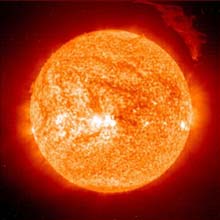SOHO snaps spectacular Sun shot

SOHO sees eruptive prominence <br>Credits: ESA/NASA
On Friday, 12 March 2004, the Sun ejected a spectacular ’eruptive prominence’ into the heliosphere. SOHO, the ESA/NASA solar watchdog observatory, faithfully recorded the event.
This ’eruptive prominence’ is a mass of relatively cool plasma, or ionised gas. We say ’relatively’ cool, because the plasma observed by the Extreme-ultraviolet Imaging Telescope (EIT) on board SOHO was only about 80 000 degrees Celsius, compared to the plasma at one or two million degrees Celsius surrounding it in the Sun’s tenuous outer atmosphere, or ’corona’.
At the time of this snapshot, the eruptive prominence seen at top right was over 700 000 kilometres across – over fifty times Earth’s diameter – and was moving at a speed of over 75 000 kilometres per hour.
Eruptive prominences of this size are associated with coronal mass ejections (CMEs), and the combination of CMEs and prominences can affect Earth’s magnetosphere when directed toward our planet. In this case, the eruptive prominence and associated CME were directed away from Earth.
SOHO is a mission of international co-operation between ESA and NASA, launched in December 1995. Every day SOHO sends thrilling images from which research scientists learn about the Sun’s nature and behaviour. Experts around the world use SOHO images and data to help them predict ’space weather’ events affecting our planet.
Media Contact
More Information:
http://www.esa.int/esaSC/SEMBYM8CURD_extreme_0.htmlAll latest news from the category: Physics and Astronomy
This area deals with the fundamental laws and building blocks of nature and how they interact, the properties and the behavior of matter, and research into space and time and their structures.
innovations-report provides in-depth reports and articles on subjects such as astrophysics, laser technologies, nuclear, quantum, particle and solid-state physics, nanotechnologies, planetary research and findings (Mars, Venus) and developments related to the Hubble Telescope.
Newest articles

High-energy-density aqueous battery based on halogen multi-electron transfer
Traditional non-aqueous lithium-ion batteries have a high energy density, but their safety is compromised due to the flammable organic electrolytes they utilize. Aqueous batteries use water as the solvent for…

First-ever combined heart pump and pig kidney transplant
…gives new hope to patient with terminal illness. Surgeons at NYU Langone Health performed the first-ever combined mechanical heart pump and gene-edited pig kidney transplant surgery in a 54-year-old woman…

Biophysics: Testing how well biomarkers work
LMU researchers have developed a method to determine how reliably target proteins can be labeled using super-resolution fluorescence microscopy. Modern microscopy techniques make it possible to examine the inner workings…





















